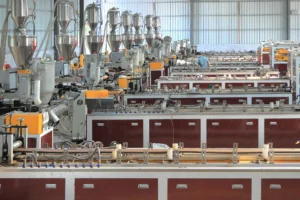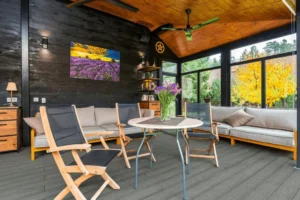The Essential Guide to Spacing Between Deck Boards for Long-Lasting Decks

Spacing between deck boards refers to the gaps between the sides and ends of deck boards. This seemingly minor detail plays a crucial role in the longevity and functionality of your deck. Proper spacing ensures a durable and safe deck, particularly important for DIY builders who want to avoid common pitfalls and maximize the lifespan of their outdoor space.
The Importance of Proper Deck Board Spacing
Proper deck board spacing is essential for several reasons. Firstly, it prevents buckling due to the natural expansion and contraction of the boards. As temperatures and humidity levels fluctuate, deck materials expand and contract. Without adequate spacing between deck boards, the boards can warp, buckle, or even crack, leading to costly repairs and an uneven surface.
Secondly, correct spacing facilitates water drainage and airflow. This helps prevent water from pooling on the deck surface, which can create a slippery and unsafe environment. Additionally, good airflow reduces moisture build-up under the deck, which is crucial in preventing mold, mildew, and rot.
Understanding Expansion & Contraction of Deck Materials
Deck materials expand and contract differently, making it important to understand these principles when planning your deck. Traditional wood and composite materials have unique characteristics that influence how they should be spaced.
– Traditional Wood: Wood primarily expands in width. When exposed to moisture, wood fibers swell, causing the boards to widen. Conversely, as the wood dries, it contracts and shrinks.
– Capped Polymer and Composite Decking: These materials expand along their length rather than width. This difference is due to their synthetic composition, which reacts differently to environmental changes compared to natural wood.
Side-to-Side Deck Board Spacing
Side-to-side spacing refers to the gap between the sides of the boards. This spacing is vital for accommodating the material’s natural expansion and contraction.
– Traditional Wood: For dried wood, a typical gap of 1/8” is recommended. If you are installing freshly treated wood, install the boards tightly with no gap to allow for natural shrinkage as the wood acclimates to the environment. Letting the wood sit in a dry area for one to two weeks before installation can help it acclimate better.
– Capped Polymer and Composite Decking: These materials require precise spacing at the time of installation, as they do not shrink side-to-side. For capped polymer decking, a gap of 1/8” to 1/4” is recommended, while capped composite decking requires a spacing of 1/8” to 7/32”. The exact spacing depends on the specific product and the type of fastener used.
– Influencing Factors: The decking line, board profile (full or scalloped), shoulder type (square or grooved), and fastener type (top-down or hidden clip) all influence the necessary spacing. Always refer to the manufacturer’s guidelines for specific recommendations.
End-to-End Deck Board Spacing
End-to-end spacing, or the gap between the ends of the boards, is equally important for preventing issues such as buckling at butt joints.
– Traditional Wood: Generally, no gap is required between the ends of the boards, as wood primarily expands in width, reducing the risk of buckling at butt joints.
– Capped Polymer and Composite Decking: These materials expand and contract along their length, making proper end-to-end spacing critical. For capped polymer decking, no gap is typically needed due to its stable material composition. However, capped composite decking requires specific gaps depending on the installation temperature. Always keep the decking as cool as possible during installation to minimize gapping.
Ensuring Proper Water Drainage & Airflow
Correct spacing between deck boards is critical for effective water drainage and airflow. Insufficient spacing can lead to several issues:
– Traditional Wood Decks: Without proper spacing, water can become trapped on the deck surface, leading to mold, mildew, and rot. This moisture can also affect the deck’s substructure, causing further structural damage. Over time, these issues can result in cracking, splitting, cupping, or warping of the boards, necessitating frequent replacement.
– Composite Decks: While composite materials are more resistant to moisture, improper spacing can still cause standing water, creating an unsafe walking surface. Ensuring adequate gaps allows water to drain away and prevents hazards.
Tools and Resources for Deck Installation
To assist with achieving the correct spacing between deck boards, several tools and resources are available:
– Deck Spacers: These tools ensure consistent spacing during installation, making the process easier and more accurate.
– Hidden Fastener: Choosing the right fasteners is crucial for maintaining proper spacing. Hidden fasteners provide a seamless deck surface, while color-matched screws blend into the deck’s appearance. Hidden clip fasteners ensure a fastener-free surface, contributing to a clean and polished look.
Conclusion
In conclusion, proper spacing between deck boards is vital for creating a durable, safe, and aesthetically pleasing deck. By understanding the unique characteristics of your chosen materials and following specific spacing guidelines, you can prevent common issues such as buckling, mold, and standing water. Utilize available tools and resources to ensure a successful deck installation that you can enjoy for years to come.
Trending Reading
What Are the Differences Between the WPC Board and PVC Board?
[2024 Update] How Long Does WPC Decking Last?











